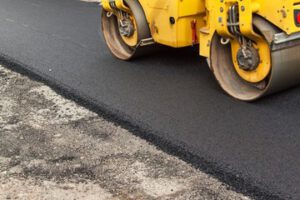The Different Types of Asphalt Paving
Asphalt Paving Charleston SC is a type of pavement made from hot asphalt cement mixed with aggregates. Once the mixture has cooled and hardened, it becomes the familiar asphalt we know and love. This material is often laid as a base mix, with the largest stones no larger than 3/8 inch. It is then laid at a minimum depth of two inches.
Hot mix asphalt paving is a process in which a mixture of asphalt and stone is laid over a porous base. This type of base is called an open-graded friction course and is much smoother than dense-graded asphalt. The materials used in the process are usually obtained from nearby asphalt plants and should be transported by truck. Before laying the asphalt, the base must be prepared for milling, and a non-petroleum product should be added to the truck bed.
This mix is the most common type of asphalt. It has great durability and impermeable properties. The mix can be coarse-graded or fine-graded, depending on the aggregates used. It is ideal for a variety of purposes, including structural, friction, and leveling applications. However, it is more expensive than the other two types of asphalt.
In the States, state transportation agencies spend millions of dollars on roads and pavements. The most common material used is Hot Mix Asphalt. It is a mixture of aggregates, bituminous material, liquid petroleum binders, and additives. Hot mix asphalt is durable and flexible and is often used for heavy-traffic areas. There are many steps involved in the process, and it requires careful inspection and oversight to ensure the contractor is performing the job correctly and within specifications.
The process of paving hot mix asphalt requires a thorough understanding of the process, equipment, and installation. It is vital for any contractor to know the material’s properties, including the proper thickness and compaction. In addition, contractors need to be familiar with the contract requirements and material tests, as well as the proper documentation and payment for their work.
Ultra-Thin Asphalt Paving is a cost-effective way to protect and maintain roads. It is an asphalt paving technology that improves ride quality and reduces traffic noise. It is a good choice for roads that show signs of aging and oxidation.
Ultra-Thin Asphalt Paving can be applied to both rigid and flexible pavements. However, it is important to repair cracks in the existing pavement before applying this type of pavement. This preventive maintenance treatment can increase the life of existing pavements by up to 6-17 years. In addition, it can be used to repair deficient surfaces and increase surface friction.
Ultra-Thin Asphalt Paving can be a good option for roads that receive heavy truck traffic. This type of asphalt consists of a mixture of open-graded aggregates, a rubberized asphalt layer, and an ultra-thin layer of asphalt. It is a popular choice for highway pavements due to its durability and smooth texture.
The quality of the existing pavement will determine the lifespan of the Ultra-Thin Asphalt Paving over it. Depending on the traffic and climate, the binder content can range from 5% to 6%. The thickness of the asphalt overlay will also determine how long it will last.
The compaction process is important for the durability of asphalt mixtures. The compaction temperature must be low enough to prevent the mixture from degrading. If the compaction temperature is too high, air voids will develop and reduce the service life of the new asphalt. This will ultimately reduce the pavement’s overall strength.
Coal tar is a type of sealant that is commonly used in asphalt paving. However, contractors may be wary of this type of sealer because it is not as forgiving as asphalt sealers. In addition, asphalt-based sealants are safer than coal tar sealers, as they do not release harmful polycyclic aromatic hydrocarbons (PAHs), which are released by burning coal, oil, trash, and other materials.